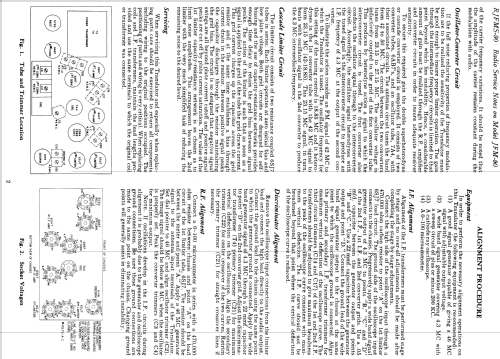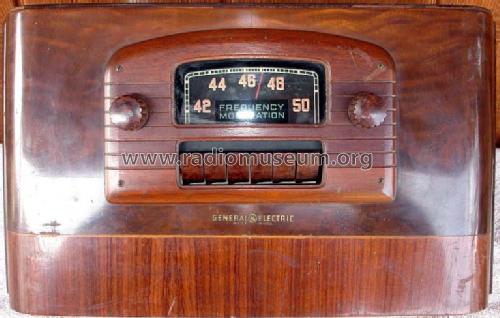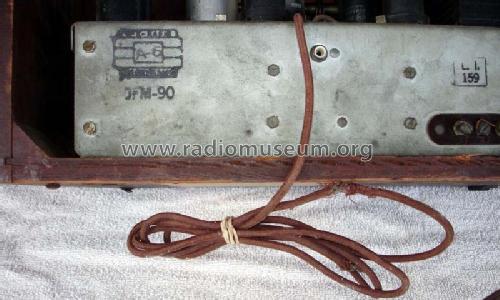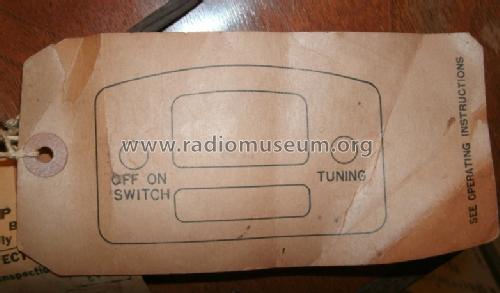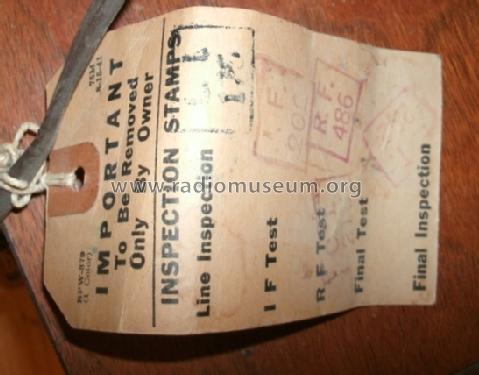- País
- Estados Unidos
- Fabricante / Marca
- General Electric Co. (GE); Bridgeport CT, Syracuse NY
- Año
- 1940–1942
- Categoría
- Radio - o Sintonizador pasado WW2
- Radiomuseum.org ID
- 42416
-
- Brand: Musaphonic
Haga clic en la miniatura esquemática para solicitarlo como documento gratuito.
- Numero de valvulas
- 9
- Principio principal
- Superheterodino doble o triple conversión; ZF/IF 23150-27150,4300 kHz; something special ? Please give information (notes)
- Número de circuitos sintonía
- 13 Circuíto(s) FM
- Gama de ondas
- Solamente FM
- Tensión de funcionamiento
- Red: Corriente alterna (CA, Inglés = AC) / 105-125 Volt
- Altavoz
- - Este modelo usa amplificador externo de B.F.
- Material
- Madera
- de Radiomuseum.org
- Modelo: JFM-90 - General Electric Co. GE;
- Forma
- Sobremesa de botonera.
- Ancho, altura, profundidad
- 15.5 x 9 x 7.3 inch / 394 x 229 x 185 mm
- Anotaciones
-
Phonograph or TV Audio connections. John F. Rider 13-76 "OSCILLATOR-CONVERTER CIRCUIT If the full noise reducing properties of frequency modulation are to be realized, the sensitivity of the Translator must be good enough to insure proper limiter operation. The gain through the intermediate frequency circuits is limited to that point beyond which lies instability. Hence a considerable amount of gain must be realized through the R. F. amplifier and converter circuits in order to insure adequate receiver sensitivity. To secure the required gain, the double superheterodyne or cascaded converter circuit is employed. It consists of tow converter tubes 6AB7's and an oscillator tube,7A4, with their associated circuits. The antenna circuit tunes tunes the band from 42 to 50 MC. The circuit between the two converters tunes from 23.15 to 27.15 MC. The oscillator voltage is inductively coupled to the grid of the first converter tube. This produces by heterodyne action a signal to which the inter-converter circuit is tuned. the first converter also conducts the oscillator signal through to the inter-converter circuit. Accordingly, the oscillator signal heterodynes with the tuned signal in the inter-converter circuit to produce an IF frequency of 4.3 MC at the output of the second converter. To illustrate the action consider an FM signal of 42 MC to which the Translator is tuned. The oscillator frequency for this setting of the tuning control is 18.85 MC signal and it heterodynes in the 1st converter tube with the 42 MC signal to form 23.15 MC (42-18.85). This 23.15 MC signal, in turn, beats with oscillator signal in the 2nd converter to produce the 4.3 MC intermediate frequency." Translator here means tuner.
- Ext. procedencia de los datos
- Ernst Erb
- Procedencia de los datos
- Rider's Perpetual, Volume 13 = 1942 and before
- Referencia esquema
- Rider's Perpetual, Volume 13 = 1942 and before
- Documentación / Esquemas (1)
- General Electric Radio Service Notes 1939-1942
- Documentación / Esquemas (2)
- Machine Age to Jet Age II (page 143.)
- Documentación / Esquemas (3)
- General Electric Folder 13-497-W for 1941.
- Otros modelos
-
Donde encontrará 2919 modelos, 2142 con imágenes y 2045 con esquemas.
Ir al listado general de General Electric Co. (GE); Bridgeport CT, Syracuse NY
Colecciones
El modelo JFM-90 es parte de las colecciones de los siguientes miembros.

